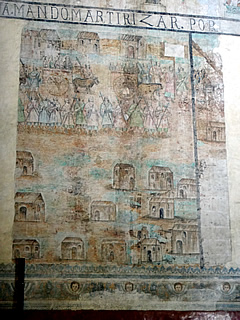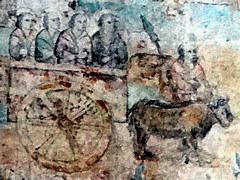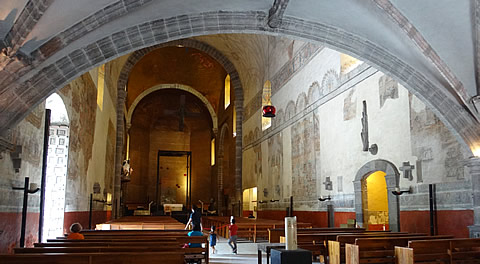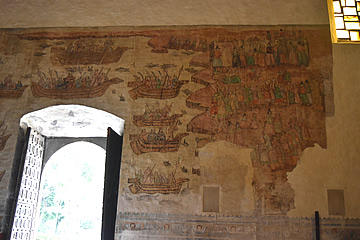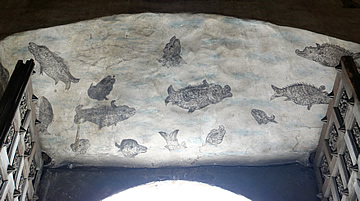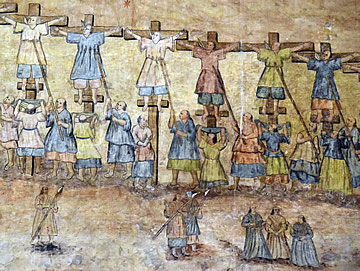

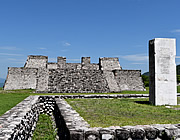
7th century Xochicalco is the prime example of an Epiclassic multicultural fortified hilltop city; the remains are extensive with some of the best relief carving we have seen anywhere. And we had an amazing experience at the "Observatory" luckily being here at a time when the sun was in the right place to shine directly into it.
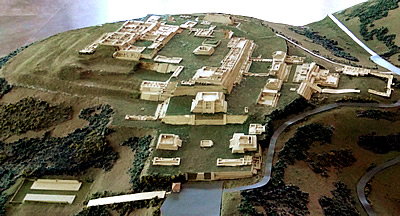
Xochicalco grew as the great city of Teotihuacan declined, and reached its peak in the Epiclassic era, roughly 650-900 AD. The era is characterised by enhanced militarism, perhaps brought about by the power vacuum left when Teotihuacan collapsed. People were on the move, escaping political uncertainty and economic instability. Thus urban centres became more cosmopolitan and developed with an eye to security.
Xochicalco is the supreme example of a fortified Epiclassic site, displaying influences from the Central Highlands, the Gulf Coast, and the Mayan region.1
The ceremonial and civic centre stands on a hilltop with tremendous views over the surrounding countryside. Residential areas occupied lower hills so that the ordinary people lived below the centre - in every sense, the elite and the gods were "above" them, reinforcing an evident class distinction.
A number of causeways end here, reminiscent of the Mayan sacbeob at Classic Maya cities such as at Tikal, Coba, Edzna and Kabah.2 There is much evidence of Mayan influence and also Teotihuacan inspiration in the architecture, with the talud-tablero style, and worship of the feathered serpent Quetzalcoatl.
The hilltop was artificially levelled and terraced to carry temples, ball courts, grand plazas and elite living areas. The lowest of the levels is surrounded by a wall so the whole could be easily defended.
The centre came to an end in fire and destruction, though the areas below these suffered no such fate. Perhaps the lower orders rebelled against those who would look down on them.

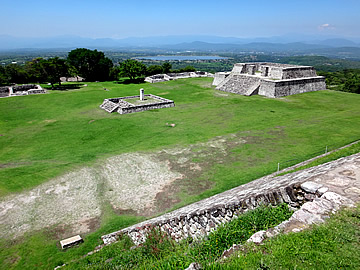
Our guide, Pepe, had rearranged our schedule slightly so that we could go to Xochicalco on this day, which was going to be sunny, and he had a surprise for us.
After a brief visit to the museum and some history Pepe took us out and up to the site. First we came to the Plaza of the Stela of the Two Glyphs.
This area was the centre of civic and ceremonial life. Though ceremonies were only for the elite the noise of of drums would have been widely heard and the people would have known something was going on. Ceremonies may well have centred on the movements of celestial bodies as the wide space, elevated above much of the surrounding landscape, is perfect for star-gazing.
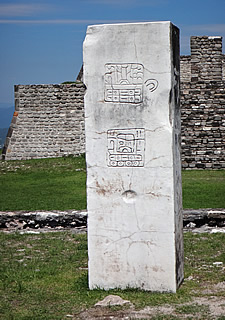
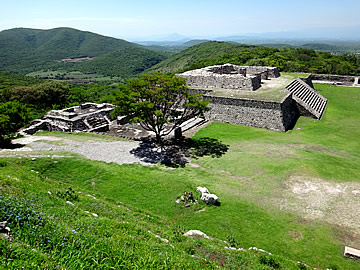
This is a beautiful wide space, a pyramid with the remains of a temple on top on each of the east and west sides and, in the centre, a platform with the stela. The two glyphs inscribed on it are both dates - 10 Acatl (Reed) and 9 Ojo de Reptil (Reptile Eye), possibly relating to Quetzalcoatl.2
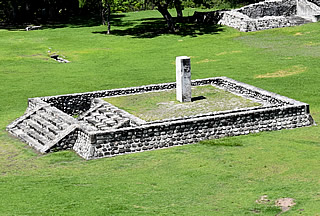
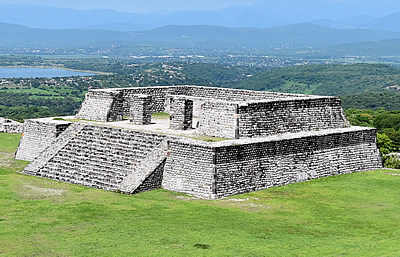
This plaza seems isolated from the main complex, as is a huge ball court to the south west.
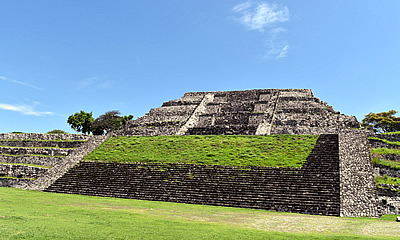
On the north side of the Plaza of the Stela of the Two Glyphs stands the Great Pyramid on its huge terraced platform, rising in four levels with a central staircase facing south. The terrace steps are the same width as the pyramid and the terraced platform extends an equal distance to east and west of the Great Pyramid so from the Plaza of the Stela it appears a unified whole.
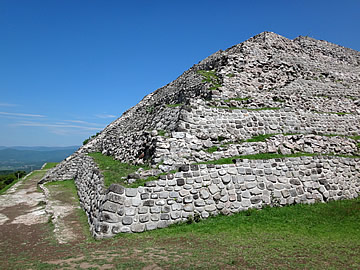
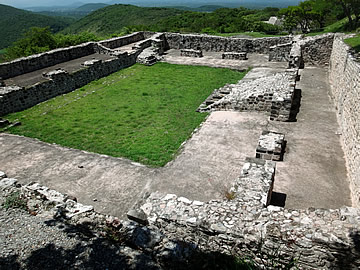
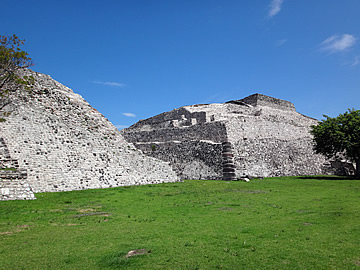
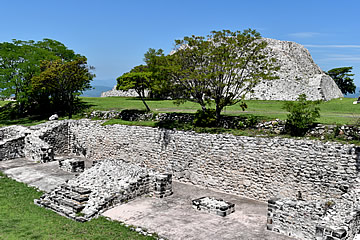
We headed east where there are substantial remains of a galleried building with a central courtyard on the south east corner of the terrace.
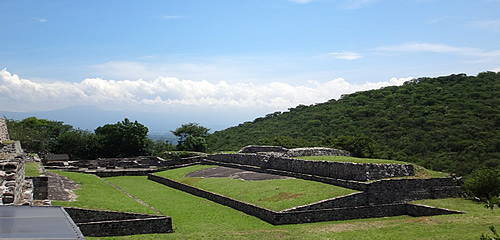
Next to it lies the East Ball Court, rectangular with typical sloping sides. What isn't typical is the wonderful ramp which provides access to it on the south side - the cobblestones of its floor are all carved with images of animals hence its name: Ramp of the Animals.
It is thought that only very important people from the ball game would be allowed to use this ramp.
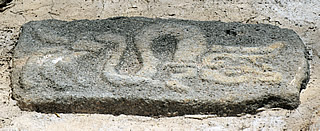
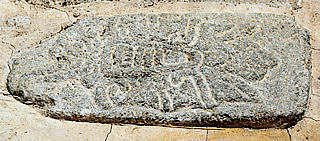
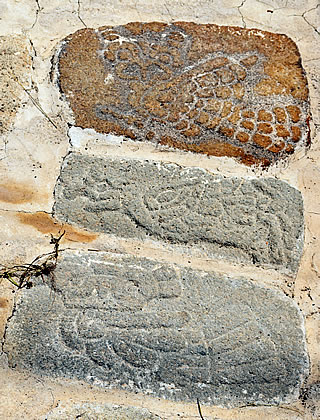
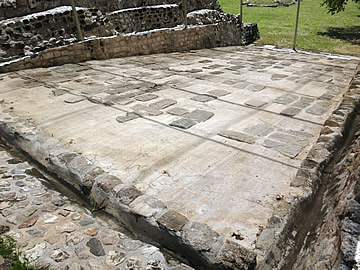
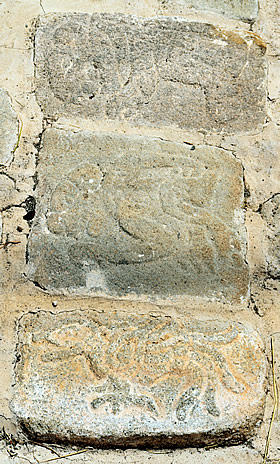
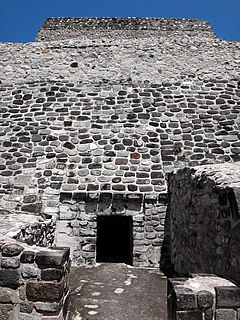
A long wall forms the west side of this space above which the structures of the upper terrace can be seen. On the east side are structures once associated with the ball court which lies below and on the further side. These include a large central pyramid flanked by two smaller pyramids - the rear elevations of all three would have been great for watching a ball game!
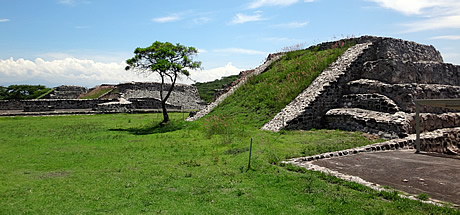
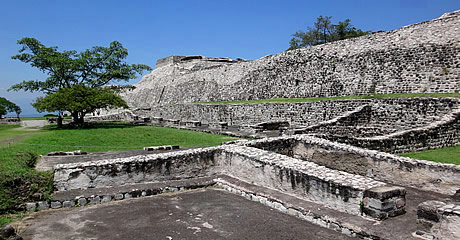
The central pyramid faces west into what was once a large galleried courtyard with rooms.
We made our way round to the north end of the ceremonial area, still beneath the upper terrace.
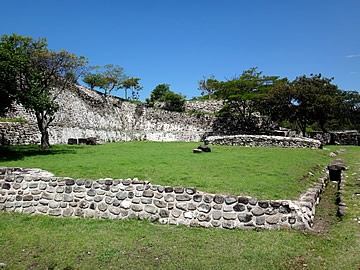
At the eastern end there is a cistern for collecting rain water, once roofed with tree trunks, clay and stones to keep the water clean. Water could be distributed through channels down the hillside to the people living below.
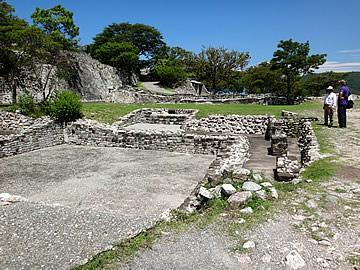
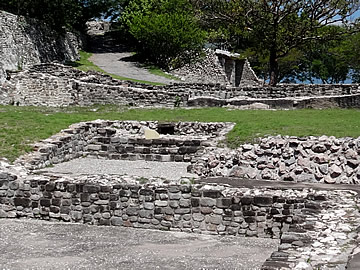
Rain falling in the courtyard of the Temazcal, a little further to the west, drained into the cistern
A Temazcal is a steam bath, it translates as "hut-like oven where one baths and perspires" - and is one of the very best examples to be seen in Mesoamerica.
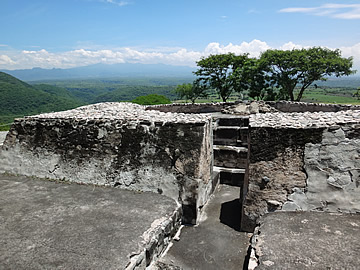 The Temazcal.
The Temazcal.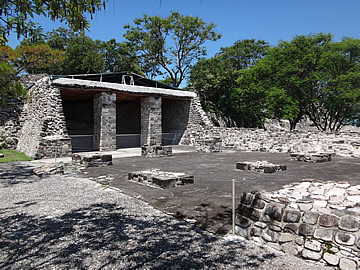
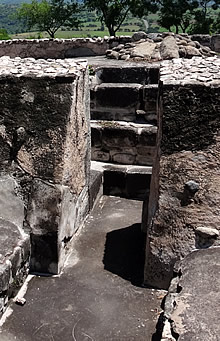
The Temazcal had adobe walls faced with stone. A room behind had a wood-burning fire for heating stones, these would be sprinkled with water to create steam.
This was not a bodily cleansing area, as such, but used for ritualistic purification, for instance of those who were to participate in a ball game. Behind and below this northern area of the terrace is the large north ball court.
Finally on this level we came to the Hall of the Polychrome Altar, a remarkable survival still with traces of mostly blue pigment. In order to protect it the building, which Pepe told us was the Temple of Tlaloc, has been partly reconstructed and roofed with thatch in the style and materials which would have been used at the time.
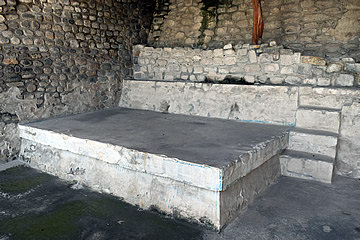
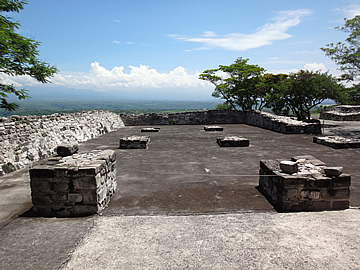
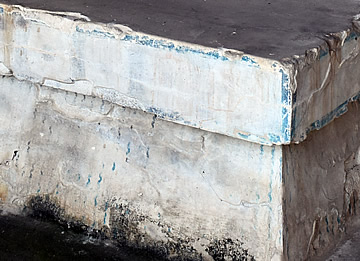
A fine pillared courtyard lies in front of the hall emphasising its importance.
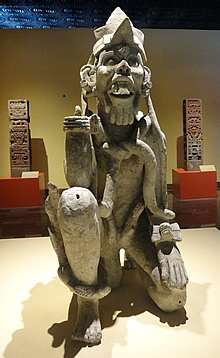
We left this terrace and climbed to the upper level and the Main Plaza. On the west side is the acropolis, the highest point of the complex, comprising buildings arranged around central patios built on an artificial 6m high platform.
Off-centre on the east side is probably the most famous of Xochicalco's structures: the Pyramid of the Plumed Serpent.

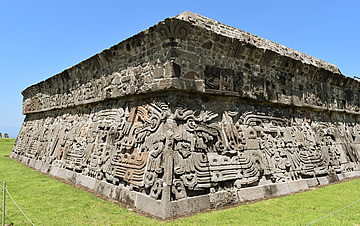
The pyramid is another talud-tablero construction, the walls carved with figures and fantastic undulating serpents. It is reminiscent of the Temple of Quetzalcoatl at Teotihuacan and may have been an attempt to copy it.2
It faces, roughly, west. There are two massive serpents carved on each of the sloping faces on the north, south and east sides. On the west side there is a wide staircase which leads to the temple.
The coils of the serpents frame a seated man in a style which is obviously influenced by Mayan art. Pepe told us that the men are thought to represent wise men such as astronomers from the four local tribal cultures, debating how to synchronise their various calendar systems.
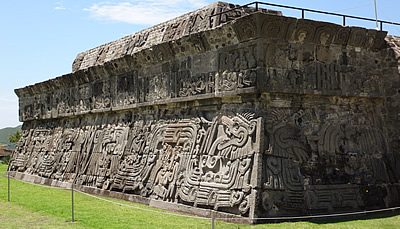
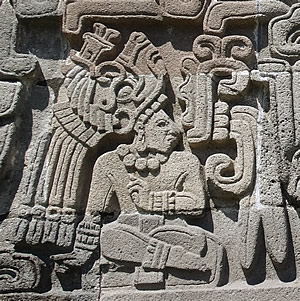
The wise men have speech curls emanating from their mouths and gesticulate with their hands in animated debate. They wear elaborate headdresses similar to the warrior headdresses on the Temple of Quetzalcoatl at Teotihuacan.

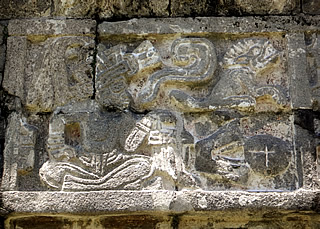
Above the carved serpents is a frieze of carvings in rectangular frames of a serpent about to swallow a quartered disc - a representation of a total eclipse of the sun, or, less romantically, the conquering of the four tribes by the Aztecs.
Very faint traces of colour, red and greenish-blue, can be made out on the panel supporting the stairs on the right.
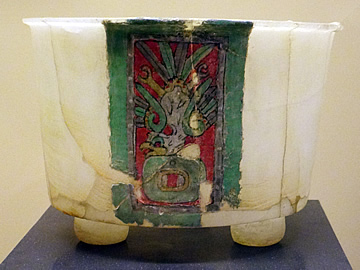 Alabaster Bowl
Alabaster BowlThere is a wonderful representation on the front left face by the stairs of the correcting of the calendar - I've tried to make sense of it using the illustrations below and information from our guide Pepe.
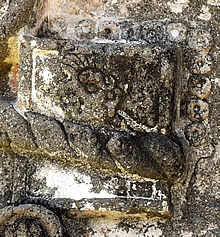
The calendar was composed of two simultaneous cycles - a 360 day cycle of 18 months of 20 days each + 5 extra days, and a 120 day ritual cycle. These concurrent two cycles were completed every 52 years. All of these numbers were of great significance.
During the time of the rise of Xochicalco many peoples were on the move and many different cultures settled in the city bringing their own beliefs and practices with them. Synchronising the calendars would have been a necessity.
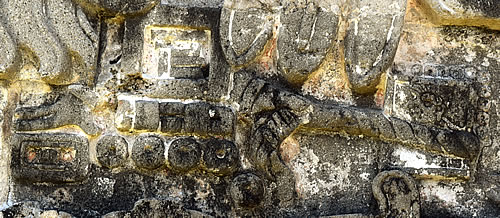
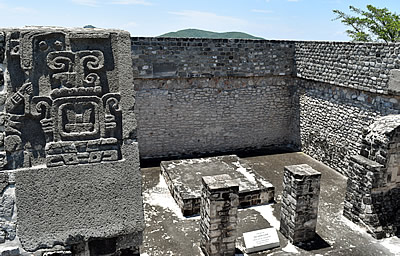
We climbed the steps to the temple level of the pyramid. Here only the lower sections of outer wall remain but the interior has been excavated to reveal an earlier temple.
Either side of what was once the entrance to the final temple built here, are panels of glyphs inscribed into the sloping walls.
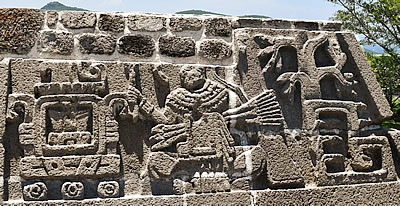
The inner edge of both panels bears the glyphs for a calendar date. In the centre is a man sitting cross-legged holding a sheaf of arrows (possibly serpent-headed?) and a torch or perhaps a flail.
The left hand panel has a carving of a dog on the outer edge, the right what looks like a tree, or possibly serpents - these ma indicate where the men came from.
The calendar date symbols are, as far as can be seen, identical on both panels apart from the number below: 10 on the left, 8 on the right.
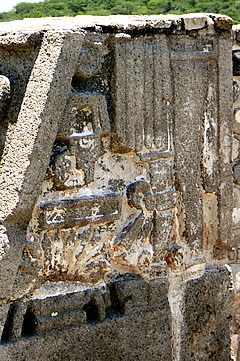
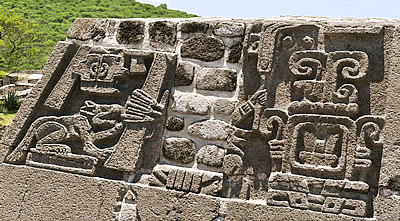
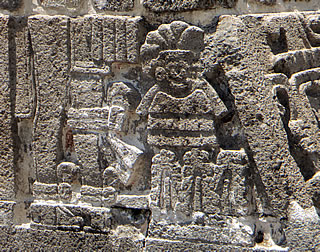
On the facing walls of the entrance the carved panels show a tantalising glimpse of two standing human figures - two sets of legs.
The two people are standing very close, one behind the other. The front figure looks to be wearing a skirt decorated with long feathers and a length of cloth tied around the leg and fastened in a flamboyant bow below the knee. The other figure wears a loin cloth with a piece hanging at the back. Both have sandals on their feet.
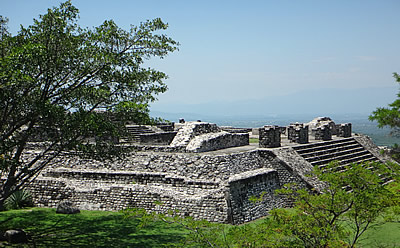
South from the Pyramid of the Plumed Serpent is the much bigger Temple of the Three Stelae. The temple is squeezed into the south east corner of the Main Plaza and living quarters and other buildings may have been demolished to accommodate it - see the plan below.
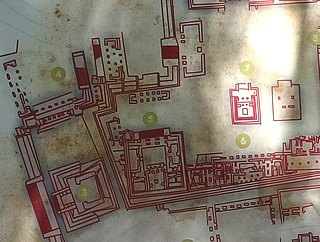

Three magnificent stelae were found in the temple - they had been deliberately broken into pieces and placed in the floor of the Chamber of Offerings. Perhaps they belonged to a previous building phase and were ritually and respectfully buried before the new temple was built.

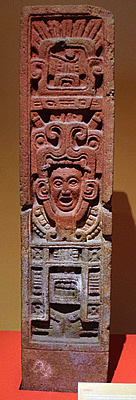
The three stelae can now be seen in the Museum of Anthropology in Mexico City and are well worth seeking out.3 The glyphs and other carvings are related to Tlaloc, the Storm God, and Quetzalcoatl. The following information comes from the museum descriptions:
Stela 1 is 143.3 cm high. Quetzalcoatl emerges from from the jaws of a mythical beast on the front face, possibly alluding to the creation of the fifth age, the age we now live in. All four faces of the stela are also carved with numbers and calendar dates.
Stela 2 is 139 cm high. Again Quetzalcoatl appears with, below, a heart spouting three drops of blood.
Stela 3 is 147 cm high. The front is carved with a Tlaloc face and related Tlaloc iconography such as fangs.
South of the Temple, on the lower terrace, stands the Great Pyramid.
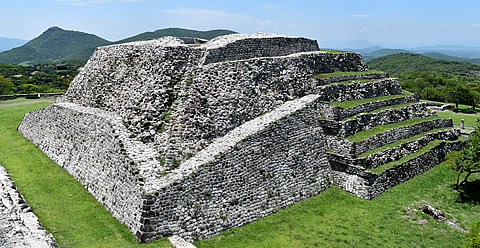
The principal entrance to the upper terrace Main Plaza is gained by a series of porticoes and grand staircases west of the Great Pyramid.
While the staircases were of an impressive magnificence, the porticoes were independent buildings, specifically designed to control access - a unique feature among Mesoamerican sites.1
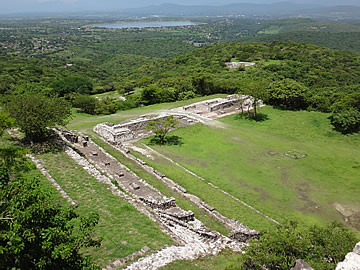
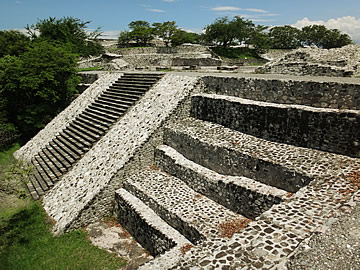
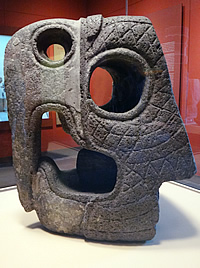
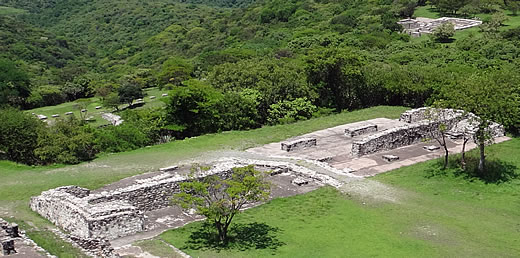
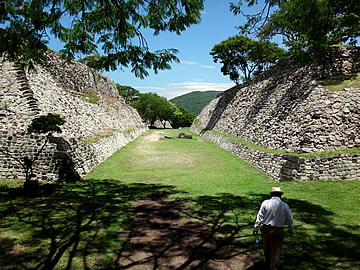
We left the Main Plaza, descending to the terrace of the cistern and further down round the back of this terrace through the north ball court This is an example with very steep walls and a shallow ledge - no two ball courts seem to be totally alike! The two rings, once fixed to the sloping walls, one on each side, high up, were lying on the ground.
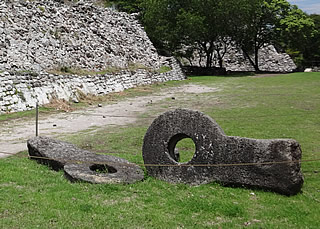
The aim of the players was to get the heavy ball, made of solid rubber, through the ring, without the use of hands or feet.
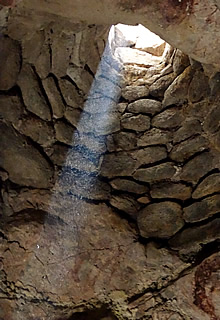
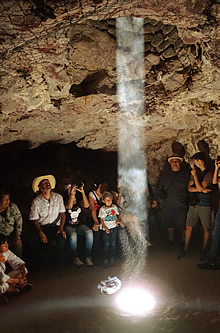
We were now coming to the Observatory, and the surprise that Pepe had promised us. The Observatory is a natural cave, one of many here, which has a shaft in its roof. Daylight penetrates the shaft, but on special days the sun shines into it to cast a beam of light in the cave. We were here on one of those days, and it was a perfect day for it.
Astronomical movement ensures that the furthest north the sun appears in the sky is over the Tropic of Cancer, and this is the time of the summer solstice, currently the 21st of June. For a few weeks either side of this date the sun will shine into the Observatory's shaft as it passes overhead. On the 14th/15th of May, and again on the 28th/29th July, the sun passes directly over the shaft. We were there on the 13th July, so very close to the peak viewing time.
The caves here were used in the early phases of occupation for quarrying stone for building purposes. Later the Observatory cave was modified to enable celestial observations and for ceremonies.1 Some local people still seem to hold on to the ancient beliefs, a woman here had a bundle she wanted to place in the beam of light - she was only allowed to put it nearby. I don't know what she thought it would confer on the shells inside.
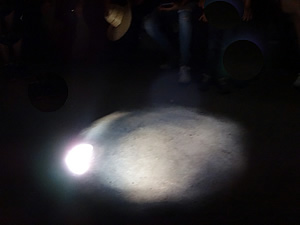
We were one of a dozen or so waiting to enter - the others seemed only to have come for this event as we'd seen no-one else as we explored Xochicalco.
The tunnels and cave are pitch black. We waited patiently until the sun hit the edge of the shaft - the guide threw sand to see the column of light better. It was extremely bright, moving across the floor as the sun moved in the sky.
Astronomical observation played a huge role in ancient societies, not just those of Mesoamerica. It was essential to know what time of year it was in order to plan agricultural activities.
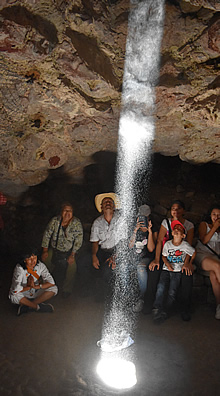
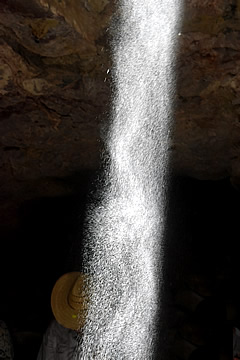
Provision of food is one of the necessities of life, so it's no wonder that peoples deified the sun, stars and other celestial bodies - these seemed to control the turning of the year and thus the agricultural seasons. In turn this would lead to significance in ceremonial activities - propitiating the various gods responsible for rain, a good harvest, etc. and these ceremonies would all have to be performed at particular times. It's a short step to adding gods of war, childbirth, etc. with their own ceremonies.
Quite an experience, and very atmospheric to think of the priests of Xochicalco standing in this place, performing their mystical ceremonies, so many centuries ago.
Xochicalco is a fantastic site, it instantly became one of my favourites. So much of interest, and so many fabulous remains.
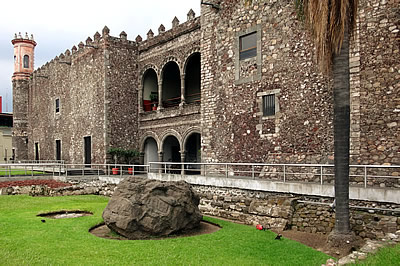
And so to lunch, though a very late one! Excellent fried beef and onion tacos with guacamole and beans washed down with a beer.
We strolled around Cuernavaca, electing not to go into the impressive Palace of Cortes. It was built in the early sixteenth century on the site of Moctezuma's palace. In the grounds there are large rocks from the original palace with glyphs.
It's a pleasant enough city, apparently with a very agreeable climate so it is a favourite place for summer residences.
We spent some time in the cathedral. Originally the church of the associated monastery, built after the conquest for the evangelisation of the indigenous people. It became a cathedral in the late nineteenth century.
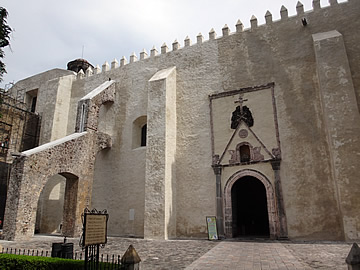
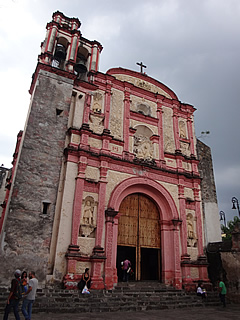
At the entrance to the cathedral is the pink Tercera Orden chapel - in fact there are a number of chapels in the complex.
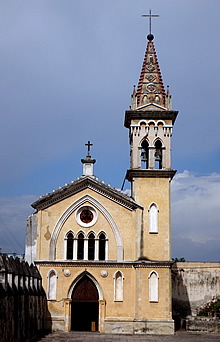
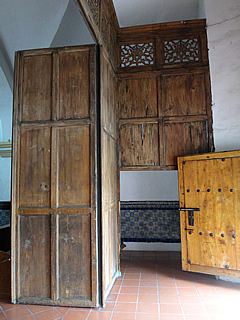
Inside the cathedral a fine series of early seventeenth century murals were uncovered during renovations. These tell the story of Mexico's first saint, Philip of Jesus. Along with 23 other Franciscan missionaries he was crucified in Japan for attempting to convert the people to Christianity.
